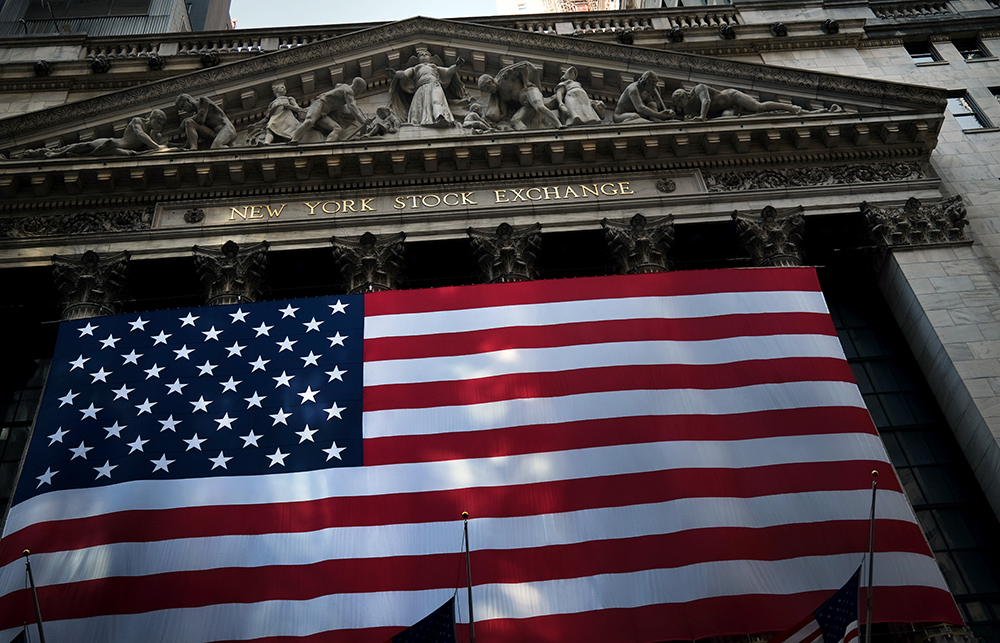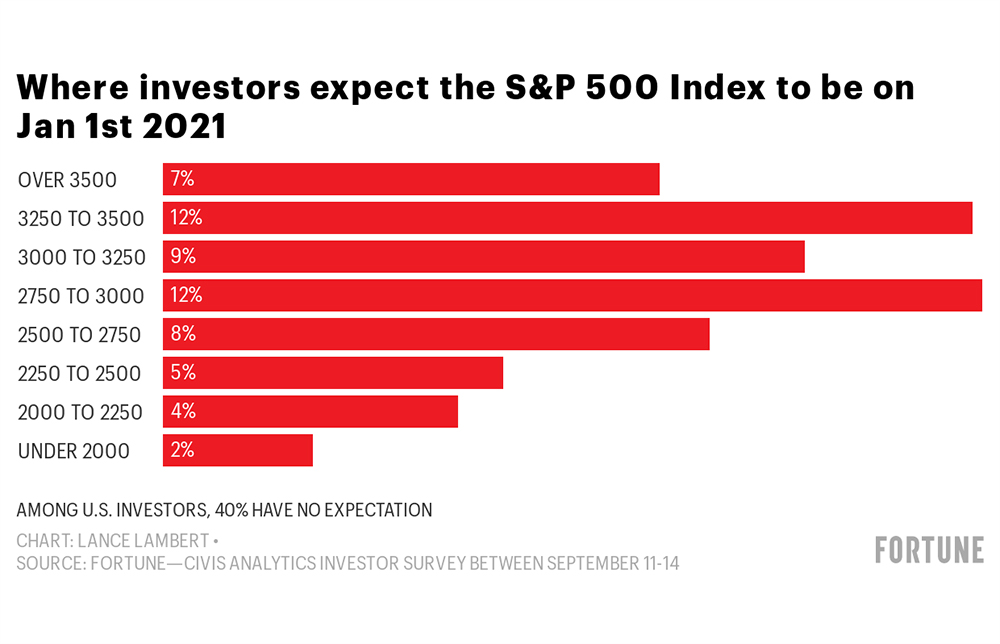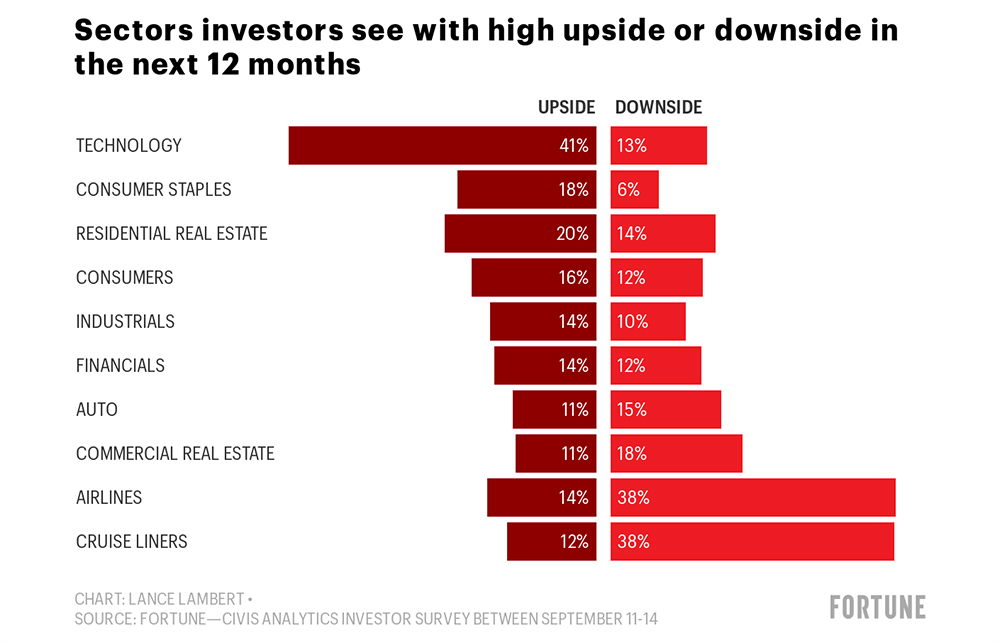
今年3月下旬,在《新冠疫情援助,救济和经济安全法案》(CARES Act)通过后,尽管美国的经济遭受重创,大幅衰退,但股市却呈现出一片欣欣向荣的利好趋势。然而好景不长:标准普尔500指数自9月2日飙升至最高点3580点以来,已经下跌近10%。
在春夏两季取得巨大收益之后,股市的这种下跌仅仅是暂时的挫折,还是更大回落的开始?投资者们还能够在哪些股票中发现上涨的空间?他们又在回避哪些股票?
为了解答这一问题,《财富》杂志联手分析机构Civis Analytics,在9月11日至14日期间,共同对1180名美国投资者进行了调查。*在上一次(3月23日这一周)进行的投资者调查中,我们发现,那时的投资者们正在计划“抄底”,趁股价跌入低谷时购进。然后,标准普尔500指数就攀升了47%。
而目前看来,投资者正在越来越倾向于做空头。只有28%的投资者认为,标准普尔500指数今年能够收于3000点以上,而认为该指数今年可以超过3500点的仅有7%。同时,有61%的人担心,股价有些飚得过高了。

9月的回落对科技股而言是残酷的。本月,纳斯达克下跌了11%,苹果和特斯拉的股价均下跌了20%。
尽管如此,投资者仍然认为,在未来的12个月中,涨幅最大的还将是科技股——3月,就在这些股票飙升之前(当时亚马逊的股价为每股1940美元,然后涨到3000美元以上),他们也是这么说的。

哪些股票是他们不会触碰的?那些有赖于回归疫情前常态的企业。投资者认为,航空公司和邮轮公司的股价仍然会持续低迷,处于谷底地位——看跌这些公司股票的人数是看涨的两倍。而在3月,他们也同样是这么认为的。
他们的看法很容易理解:由于疫情将继续阻碍商务和休闲旅行,航空公司仍然在以每天数百万美元的速度亏损。(财富中文网)
*调研方法:《财富》杂志和Civis Analytics公司在9月11日至14日期间,对1180名美国投资者进行了调查。调查对象必须通过股票或债券等金融资产的形式进行过交易。
编译:陈聪聪
今年3月下旬,在《新冠疫情援助,救济和经济安全法案》(CARES Act)通过后,尽管美国的经济遭受重创,大幅衰退,但股市却呈现出一片欣欣向荣的利好趋势。然而好景不长:标准普尔500指数自9月2日飙升至最高点3580点以来,已经下跌近10%。
在春夏两季取得巨大收益之后,股市的这种下跌仅仅是暂时的挫折,还是更大回落的开始?投资者们还能够在哪些股票中发现上涨的空间?他们又在回避哪些股票?
为了解答这一问题,《财富》杂志联手分析机构Civis Analytics,在9月11日至14日期间,共同对1180名美国投资者进行了调查。*在上一次(3月23日这一周)进行的投资者调查中,我们发现,那时的投资者们正在计划“抄底”,趁股价跌入低谷时购进。然后,标准普尔500指数就攀升了47%。
而目前看来,投资者正在越来越倾向于做空头。只有28%的投资者认为,标准普尔500指数今年能够收于3000点以上,而认为该指数今年可以超过3500点的仅有7%。同时,有61%的人担心,股价有些飚得过高了。
9月的回落对科技股而言是残酷的。本月,纳斯达克下跌了11%,苹果和特斯拉的股价均下跌了20%。
尽管如此,投资者仍然认为,在未来的12个月中,涨幅最大的还将是科技股——3月,就在这些股票飙升之前(当时亚马逊的股价为每股1940美元,然后涨到3000美元以上),他们也是这么说的。
哪些股票是他们不会触碰的?那些有赖于回归疫情前常态的企业。投资者认为,航空公司和邮轮公司的股价仍然会持续低迷,处于谷底地位——看跌这些公司股票的人数是看涨的两倍。而在3月,他们也同样是这么认为的。
他们的看法很容易理解:由于疫情将继续阻碍商务和休闲旅行,航空公司仍然在以每天数百万美元的速度亏损。(财富中文网)
*调研方法:《财富》杂志和Civis Analytics公司在9月11日至14日期间,对1180名美国投资者进行了调查。调查对象必须通过股票或债券等金融资产的形式进行过交易。
编译:陈聪聪
After the late March passage of the CARES Act, stocks went on a tear even as the economy plummeted. But that run is over: The S&P 500 Index has declined nearly 10% since its peak at 3,580 points on Sept. 2.
Is this just a temporary setback, after a spring and summer of huge gains, or the start of a bigger pullback? Where can investors still find upside—and what stocks are they avoiding?
To find out, Fortune and Civis Analytics joined up to survey 1,180 U.S. investors between Sept. 11 and 14.* When we last surveyed investors, the week of March 23, we found that they were planning to buy the dip. Then the S&P 500 climbed 47%.
Now it looks like investors are getting more bearish. Only 28% of investors see the S&P 500 finishing the year above 3,000 points, and a meager 7% see it over 3,500 points. Meanwhile, 61% are worried stocks are overpriced.
The September pullback has been brutal for tech stocks. This month, the Nasdaq has fallen -11%, and both Apple and Tesla shares are down 20%.
Nevertheless, investors still see tech stocks as having the most upside in the coming 12 months. They told us the same back in March, right before those stocks soared (Amazon was $1,940 per share at the time; then it went up to over $3,000).
What stocks aren't they touching? Those of businesses that rely on things returning to a pre-COVID normal. By a 2 to 1 ratio, investors see airlines and cruise lines to have the most downside—still. In March, they felt the same.
It's easy to see their perspective: Airlines are still losing millions per day as the pandemic continues to hamper business and leisure travel.
*Methodology: The Fortune–Civis Analytics poll was conducted among 1,180 investors in the U.S. between Sept. 11 and 14. Investors must trade financial assets like stocks or bonds.






